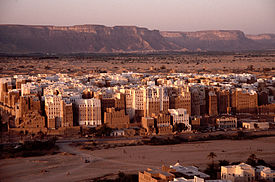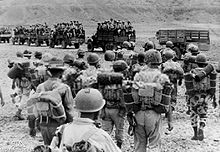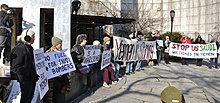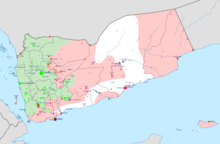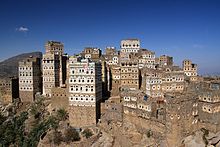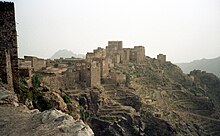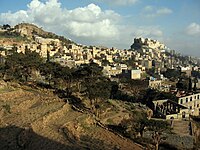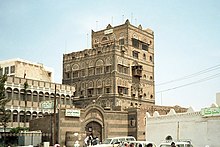Yemen
Yemen or Yemen, officially the Republic of Yemen (Arabic: الجمهوريّة اليمنية, Al-Ŷumhūriyya al-Yamaniyya), is a bicontinental country located in the Middle East. Its Asian part is located in the Mashreq, south of the Arabian peninsula, surrounded by the Arabian Sea, the Gulf of Aden and the Red Sea, in Asia. The island of Socotra is on the African continental shelf. It shares borders with Oman and Saudi Arabia. It is the only republican state in the Arabian peninsula. Its capital and most populous city is Sana'a.
The current Republic of Yemen arose in 1990 after the unification of the Yemen Arab Republic (North Yemen) and the People's Democratic Republic of Yemen (South Yemen). North Yemen achieved independence in 1918 with the partition of the Ottoman Empire, while the British maintained control in the south of the country until 1967, when South Yemen was born. The two countries were formally unified as the Republic of Yemen in 1990. A secessionist movement in the south was quickly dissipated in a brief civil war in 1994. In 2000, Yemen and Saudi Arabia agreed to the final delimitation of their borders.
Yemen is an underdeveloped country, and is the poorest country in the Middle East. Under the rule of President Ali Abdullah Saleh, Yemen was described as a "kleptocracy".
Under the context of the Arab Spring, Yemen has been in political crisis since 2011, beginning with street protests against poverty, unemployment, corruption and President Saleh's plan to amend the Constitution and remove term limits presidential, effectively making him president for life. President Saleh resigned, and the powers of the presidency were transferred to Vice President Abd Rabbuh Mansur al-Hadi, who was officially elected President on February 21, 2012 in a one-person election. The transition process was interrupted by conflicts between the Houthis and Al-Islah, as well as the Al-Qaeda insurgency. In September 2014, the Houthis seized Sana'a, later declaring control of the country after a coup. This resulted in renewed civil war and a Saudi-led military intervention to prevent the fledgling government's collapse. from Hadi.
Saudi Arabia, since 2015, has exercised a blockade that prevents the importation of food, triggering the biggest humanitarian crisis of the moment.
Etymology
In Arabic, Yemen (يمن yaman) means “right”. There are several explanations about the meaning of this name: some classical Arab authors affirm that it is due to the fact that the country is to the right of Mecca or the rising sun. Others say it is because Yoqtan, also called Qahtan—ancestor of the southern Arabs according to the Table of Nations in Genesis—turned to the right when, coming down from northern Arabia, he settled in present-day Yemen. A final theory derives the name from Qahtan's son, the eponymous hero Yaman Ibn Qahtan.
History
Yemen is one of the oldest centers of civilization in the Near East. Its land, relatively fertile in some valleys, and its humid climate allowed the development of a stable population. Its inhabitants, nomads, dedicated themselves throughout ancient times to grazing and raising birds.
The Greek geographer Claudius Ptolemy referred to Yemen in his texts as Eudaimon Arabia (a term better known by its Latin translation, Arabia Felix). The Mediterranean peoples saw caravans loaded with incense, myrrh, cassia, cinnamon and laudanum arrive; or riches such as gold, ebony, ivory and silk, from which they deduced that it was a fabled land. Its greatest splendor was the Kingdom of Sheba –capital, Mariaba (Marib)– with its mysterious queen and her love affair with the Jewish King Solomon, which gave rise to the myth. The legend of Arabia Felix resurfaced in the XVII, when French, English and Portuguese merchants heard of a drink, "gold". black” – coffee – which was exported to the entire world through the Yemeni port of Moca.
The area was dominated by three successive civilizations between the 12th century B.C. C. and the 6th century, who controlled the lucrative spice trade: the Mineans, the Sabeans and the Himyarites.
The Kingdom of Sheba, whose capital was Marib, achieved great power due to its strategic location, between India and the Mediterranean, which allowed it to monopolize the spice trade. The legendary Queen of Sheba of the Old Testament supposedly originated from there. The kingdom of came to be dominated from the third century AD. C. by the himyarita dynasty, reason why it is spoken of the Kingdom of Himyar. It was then annexed by Sasanian Persia in 572.
Islam arrived in Yemen around the year 630; thereafter, Yemen became part of the Arab caliphates and became dependent first on Damascus and then on Baghdad. During the eighth century, small independent states began to appear in Yemen, such as the Zaidi or Zaidite dynasty, followed by others. In the centuries that followed, Yemen wavered between independence and submission first to the caliphs of Egypt and then to the sultans of the Ottoman Empire.
Portuguese
From the 15th century, Portugal intervenes, which dominated the port of Aden for about twenty years and held during this period a fortified enclave on the island of Socotra.
Since the 1500s, the Portuguese posed an immediate threat to Indian Ocean trade. The Mamluks of Egypt therefore sent an army under Hussein al-Kurdi to fight the intruders. The Mamluk sultan of Egypt went to Zabid in 1515 and entered into diplomatic talks with the Tahiri sultan 'Amir bin Abdulwahab for the money that would be needed for the jihad against the Portuguese. Rather than confront them, the Mamluks, who were running out of food and water, landed on the Yemeni coast and began harassing the Tihama villagers to obtain the food they needed. Portugal's interest in the Red Sea consisted, on the one hand, in guaranteeing contacts with a Christian ally in Ethiopia and, on the other, in being able to attack Mecca and the Arab territories from the rear, while gaining absolute control of trade. of spices. He also sought to dominate the trade of the coastal cities of Africa and Arabia. To this end, he sought to influence and dominate by force or persuasion all warring ports and kingdoms. It was common for Portugal to make Arab allies interested in maintaining the autonomy of other Arab states in the region.
18th century
In the 18th century, Ibn Saud, founder of the Saudi dynasty, annexed Yemen, which later returned, after a brief period of independence, to Egyptian rule, in the first half of the 19th century. The British settle in Aden in 1839, and become a preponderant power in the area.
Yemen achieved independence after World War I, becoming a kingdom. In 1926 there was a new Saudi intervention, but the following year the Zaydite imam regained the throne. The new border disputes with the neighboring country were finally resolved with the delivery of the Asir region to Saudi Arabia.
At the time, the area of Aden was still under British rule, with the name of South Arabia; in 1937 the area was divided into a colony (Aden) and two protectorates, eastern and western, with broad autonomy and a Federal Supreme Council.
During the 20th century, Yemen made important strides in international cooperation: in 1945 the Kingdom of Yemen joined the the Arab League, and in 1947 at the UN. The last king was overthrown in 1962, and the Yemen Arab Republic, known as North Yemen, was established, although an almost parallel civil war raged between the monarchists, who drew support from Saudi Arabia, and the republicans, who were aided by Egypt with material aid and a significant contingent of troops. The fight lasted until 1970, when the Republicans prevailed.
In the Aden region, in 1963 anti-British groups opposed to the country coming under the influence of London in the near independence, with help from the other side of the Yemeni border, began guerrilla and terrorist attacks. In the following years, the violence increased with numerous victims, but despite Great Britain's efforts to prevent it, in 1967 it had to negotiate with the rebels and the former British domain became the People's Democratic Republic of Yemen or South Yemen. of Marxist orientation, which was the first communist Arab state.
The revolutionary positions of the South Yemeni government caused its isolation within the Arabian Peninsula. The region's absolute monarchies considered themselves threatened and viewed South Yemen as the vanguard of possible revolutionary movements in their own states. These, particularly Saudi Arabia, favored the economic isolation of the country and supported armed incursions by opposition groups, forcing the regime to focus on military and defense spending at the expense of development. South Yemen was the target of several military interventions: by Saudi Arabia in October 1968, December 1969 and November 1970; from North Yemen in September and October 1972 and then in 1979; and British aircraft bombed and destroyed the town of Hauf in May 1972.
Economic difficulties were aggravated by the closure of the Suez Canal from June 1967 (on which much of the port of Aden's activities were based) and by the flight of the economic elite from the private sector, which He took his financial assets with him. The largely deserted interior had limited potential.
Despite this hostile environment, the South Yemen regime adopted major political, social and economic reforms: universal education, free health services, formal equality for women. The government also tried to fight tribalism. The gap between rural and urban living conditions has narrowed considerably; the regime, some of whose leaders were of rural origin, ensured that the countryside was not neglected despite its low population density and the geographic size of the country. However, recurring conflicts between factions within the government will eventually undermine its credibility.
In 1981 a draft Constitution was finally reached for a reunified state. Thus, on May 22, 1990, both republics merged into one, the Republic of Yemen. The coexistence between the two territories will not be easy, producing a small civil war in 1994 in which the north imposes its hegemony. The truth is that the discontent of the south in relation to a union, in which they considered they had been discriminated against, has continued and has given rise to tensions and even confrontations.
In 2011, after a series of rebellions and protests throughout the Arab world, Yemeni citizens rebelled against the regime of Ali Abdullah Saleh, through a series of peaceful demonstrations that were violently repressed by the government. Despite the promise of an orderly and progressive transition of power, by the end of March 2012, many groups were still continuing with the protests in the State. The political and social situation in the country worsened throughout 2012, until the removal of the President was achieved.
The Yemeni rebellion weakened the country and allowed the entry of al-Qaeda. The Army is currently fighting intensely in southern Yemen to liberate several cities that are under its control.
War in Yemen
On March 25, 2015, an international coalition led by Saudi Arabia launched airstrikes against the Houthi armed group in Yemen, triggering a full-blown armed conflict.
Since then, the conflict has spread and fighting has spread throughout the country. War crimes and horrific human rights abuses are being committed across Yemen, causing unbearable suffering for the civilian population.
In November 2017 the conflict continued, in the city of Aden a barracks was attacked with a car bomb. leaving at least 6 officers dead.
A report released by the European Commission in December 2018 estimated 60,000 fatalities in the conflict, compared to the 10,000 that the UN has kept in its records since 2016.
Government and politics
Since the unification of the Yemen Arab Republic (North Yemen) and the Yemen Democratic Republic (South Yemen) in May 1990, the type of The government is semi-presidential, it is based on a Presidential Council of 5 members (three from the North and two from the South), headed by the highest president, Abd Rabbuh Mansur al-Hadi. The president appoints the prime minister, with the former being the head of state and the latter being the head of government.
Parliament is bicameral, and is made up of an Assembly of Representatives of 301 deputies, as well as a shura council of 111 members. The main attribution of the parliament is to legislate, but the president has a wide influence, since the General People's Congress (the party to which Saleh belongs) dominates the political life of the country, due to the fact that it has 238 members in parliament.
The president is elected by universal suffrage for a 7-year term and the parliament for a 5-year term.
The country is governed by a constitution approved by referendum on May 16, 1991, with the union of Yemen; This was later reformed, in 1994 and 2001.
Political parties
The composition of the party system in Yemen is that of the hegemonic party, although the existence and competition with other parties has been present since the unification of the state. The hegemonic party, and therefore that of the regime since 1982, is the General People's Congress (GPC). It was formed by the president and his political group years after the creation of the Yemen Arab Republic. It served to justify the interests of the State in multiple instances and does not admit real political competition. Al-Islah is the Islamist party, made up of a faction of the Muslim Brotherhood, tribes and the Sunni Salafi branch. This party appeared as a legitimizing competition for the regime, after the unification of Yemen in 1990, but little by little it separated from the control of the regime. The Socialist Party, a remnant of Aden's colonial history, served as a counterbalance to Saleh's party in 1990, but immediately lost steam. Political competition is currently hampered by an electoral system that favors districts controlled by the regime, despite Saleh's departure from the presidency.
Tribes in Yemen
Yemen is one of the countries in the Middle East that maintains a close relationship with its tribal past in a large part of its territory. And the composition of the country currently responds to these dynamics. The tribal component in the Yemen Arab Republic was an important part of Ali Abdullah Saleh's success and consolidation of his regime in the late 1970s.
The tribal composition in Yemen is concentrated in what was formerly the Yemen Arab Republic, that is, the north of the country. This derives from the historical closeness that there is with the Zaydi imamate and its reinforcement of tribal practices. In the south, the story was different due to the British presence in Aden and other eastern Yemeni protectorates. The communities that retained some link with this type of organization were adapting to the new patterns of behavior proposed by European influence, and ended up becoming peasant communities that affiliated with a party or organization, due to their interests.
The main tribes in the state are the Hashid and the Bakil, both confederations settled in the north of the country, with ideological remnants of the Zaydi imamate. The Hashid tribe had, for a long time, a close relationship with the Saleh regime; his boss 'Abdullah Ibn Husayn was in charge of promoting the interests of the regime for years. The power of the tribes should not be diminished, since we are not talking about a small section of the population, but thousands of people who respect the opinion of their sheikhs. When these leaders participate in some type of negotiation or network of influences, the tribal structure serves to give legitimacy to any institution, organization or movement.
Human Rights
In terms of human rights, regarding membership of the seven bodies of the International Bill of Human Rights, which include the Human Rights Committee (HRC), Yemen has signed or ratified:
The Report on Trafficking in Persons (Trafficking in Persons, TIP) is a relevant document that describes well the situation of respect for Human Rights and the lives of people around the world. The 2019 report finds that the civil conflict and humanitarian crisis in Yemen continued during the reporting period, since March 2015, when much of the Government of the Republic of Yemen (ROYG) took cover against the Houthi attack in Riyadh. and ceased to control significant portions of the country.
Since the escalation of the armed conflict in March 2015, human rights organizations reported that all parties involved in the conflict continued their illegal recruitment and use of children including as uniformed soldiers in combat and for guard and security checkpoints. military installations.
Some Saudi men used legally contracted "temporary marriages", authorized by Islamic authorities, for the purpose of sexually exploiting Yemeni girls, some reportedly as young as 10 years old.
In 2019, two million children are out of school, mainly because of the war. In addition, teachers' salaries have gone unpaid for more than two years, and 20% of schools are unusable.
Situation of women in Yemen
The unification of Yemen meant the interaction of societies that had developed their history very differently. The personal status code of both republics was different and in 1990 both leaderships had to negotiate the code. An agreement was reached in 1992, and below are some of the most important points:
- Marriage and divorce are still valid without registering before the authority (the State has no control over such practices).
- The wife owes obedience to her husband and the husband must take care of the maintenance of the house.
- The wife may apply for divorce only in court.
- Polygamy was restricted but only on paper and must be justified by man with a valid reason. Both wives should be notified that they will live in a polygamous marriage although it is not specified what this procedure is.
- It is established as a minimum age for marriage, the age of 15, although it is not in this code and therefore does not invalidate a marriage with a smaller girl.
The situation of women in the State is one of the least favorable for them. The mobilization of this sector of society has been favored by the Al-Islah party, but moments like the riots in 2011 show that there are still demands that the parties do not take into account. The imposition of a quota system, gender equality at work and in social life, as well as opportunities like those of their male compatriots, are some of the slogans of the movement.
In 2008, Nujood Ali, a ten-year-old girl who had been forced to marry a man in her thirties, obtained a divorce and was able to resume her studies. The case drew international attention and inspired other girls in similar situations to try the same thing as her.
Political-administrative organization
Yemen is divided into twenty governorates (muhafazah, muhafaza singular) and one municipality. It created the municipality of Amanah al-'Asmah, corresponding to the capital area of the country, and the new governorate of Raymah, in addition to the island of Socotra passing as an integral part of the Governorate of Hadramaut. The governorates are divided into 333 districts, which are further subdivided into 2,210 sub-districts, and then into 38,284 municipalities (as in 2001).
|
The data referring to area and population of each of the governorates (and municipalities) are collected in the following table:
| Governance (Muhafazah) | Surface (km2) | Population (2004) | Capital |
|---|---|---|---|
| Abyan | 16.500 | 433.819 | Zinjibar |
| Aden | 750 | 589.419 | Aden |
| Ad Dali' | 4,000 | 470.564 | Ad Dali' |
| Al Bayda' | 9.300 | 577.369 | Al Bayda |
| Al Hudayda | 13.300 | 2.157.552 | Al Hudayda |
| Al Jawf | 39.500 | 443.797 | Al Hazm |
| Al Mahrah | 82.405 | 88.594 | Al Ghaydah |
| Al Mahwit | 2.300 | 494.557 | Al Mahwit |
| Amanat Al Asimah | 400 | 1.747.834 | Sana |
| 'Amran | 7.900 | 877.786 | 'Amran |
| Dhamar | 7.600 | 1.330.108 | Dhamar |
| Hadramaut | 191.737 | 1.028.556 | Al Mukalla |
| Hajjah | 8.300 | 1.479.568 | Hajjah |
| Ibb | 5.400 | 2.131.861 | Ibb |
| Lahij | 12.700 | 722.694 | Lahij |
| Marib | 17.500 | 238.522 | Marib |
| Raymah | 1,900 | 394.448 | |
| Sa'dah | 12.400 | 695.033 | Sa'dah |
| Sana | 11,900 | 919.215 | Sana |
| Shabwah | 39,000 | 470.440 | Ataq |
| Socotra | 3.796 | 44.120 | Hadiboh |
| Taiz | 10,000 | 2.393.425 | Taiz |
Prior to 1990, Yemen existed as two separate entities. For more information see Historical Organization of Yemen.
Geography
Yemen is located in the Middle East, on the southern Arabian peninsula, bounded by the Arabian Sea, the Gulf of Aden, the Red Sea, western Oman, and southern Saudi Arabia. Until relatively recently, its northern border was not defined, because the Arabian desert prevents any human settlement there. It is considered one of the cradle zones of humanity.
Certain islands in the Red Sea belong to Yemen, the islands of Hanish, the island of Kamaran and the volcanic islands of Perim and Jabal al-Tair; and in the Arabian Sea, the island of Socotra. With 527,970 km², Yemen, by extension, ranks 49th in the world (after France), being its size similar to Thailand, and slightly larger than the state of California (USA) and Spain. Yemen is located 15° N 48° E.
The western sector of Yemen is predominantly mountainous, with elevations exceeding 3,500 meters, while the eastern sector is basically plateaus, dominated by desert. There are no permanent rivers and rainfall is very low. The temperatures, normally very high, are milder in the maritime areas and in the mountains.
The country can be divided geographically into four main regions: the western coastal plateau (Tihamah), the western mountains, the eastern mountains, and the Rub al-Khali in the east, the largest sand desert in the world.
The Tihamah (“hot lands”) region is a very arid and flat coastal plateau. Despite the aridity, the presence of many lagoons makes it a very swampy region, with abundant malarial mosquitoes. There are also large areas of shifting, crescent-shaped sand dunes (known as 'barhan'). Evaporation in Tihama is so great that the mountain streams never reach the sea, but they contribute to the existence of large underground water reserves, reserves that today are intensively exploited for agricultural use.
The Tihamah ends abruptly in the rugged western mountains. This region, now too terraced to meet the demand for food, receives the highest rainfall in Arabia, rising rapidly from 100mm per year to 760mm in the city of Taiz and reaching 1000mm in the city of Ibb. Agriculture here is very diverse, with sorghum crops predominating, but also cotton and also many fruit trees, mango being the most appreciated. Temperatures are warm during the day but drop dramatically at night. There are permanent streams in the mountains, but they never reach the sea due to high evaporation in the Tihama.
The Central Highlands region is a large plateau at about 2,000m elevation. It is drier than the western mountains due to the shelter of the mountains, but still receives enough rain in wet years to be cultivated. The variation in daytime temperatures is among the highest in the world: the normal range is from 30 °C during the day to 0 °C at night. Water storage allows irrigation and the growth of wheat and barley. The capital of Yemen, Sanaa, is located in this region, at 2,350 m. Yemen's highest point is also here, and that is Jabal al Nabi Shu'ayb, at 3,760 meters.
The Rub al-Jali desert region in the east is much lower, generally below 1,000m, and receives almost no rainfall. It is populated solely by Bedouins who own large herds of camels.
Mountain passes
It is an unknown place in the international arena, but it is home to large mountain passes as it is a country surrounded by mountain ranges and steep mountains.
| Name | Altitude(m) | Asphalt | Road | Coordinates |
|---|---|---|---|---|
| Jabal Sabr Pass | 2883 | Yeah. | 13°31′13.1′N 44°03′06.7′E / 13.520306, 44.051861 | |
| Aqabat Thirah | 2265 | Yeah. | N6 | 13°53′28.9′′N 45°45′29.2′′E / 13.891361, 45.758111 |
| Hayjat Al-Abed Pass | 2140 | Yeah. | Hayjat Al-Abed Road | 13°12′40.4′N 44°10′15.6′′E / 13.211222, 44.171000 |
Ecology
Yemen is a desert country. WWF distinguishes up to six different ecoregions in the territory of Yemen: from the coast inland there is the cloudy coastal desert of the Arabian peninsula, the piedmont savannah of southwestern Arabia, the tropical desert and semi-desert of the Red Sea and the desert and xerophytic forest of Arabia and Sinai; in addition, the western mountains, above 2,000 m, belong to the high bush of southwestern Arabia, and the island of Socotra is assigned to the Socotra xeric scrubland.
Economy
In Yemen, where barely 1% of the area is irrigable, the economy is still very archaic. Within the agricultural sector, it is worth mentioning cereal crops (millet, sorghum, wheat) and coffee. Yemeni livestock is quite important, especially with regard to sheep farming. Recent oil discoveries have made this country a producer state. The subsoil contains considerable reserves of natural gas. It also has industries related to the manufacture of plastic materials, such as the manufacture of pipes and accessories; there are also food, textile, lumber, chemical, tobacco, and paper products industries.
Its main trading partners are Thailand, China, South Korea, Singapore, Japan, and Saudi Arabia.
Note that Yemen is one of the poorest countries in the world, with a GDP per capita of $2,473 (2009). Especially as a consequence of the civil war unleashed in 2014, in 2021 80% of its population lived below the poverty line and two thirds (21 million people) required humanitarian aid to survive.
Telecommunications and media
In Yemen there are 7 television stations (data as of January 2006) and 9 radio stations: 6 in AM, 1 in FM and 2 in shortwave (data as of January 2006). It has 798,100 fixed telephone lines in use (2004) and 2 million mobile telephone lines (2005). There are 220,000 Internet users (2005). His internet domain is .ye.
Demographics
Yemenis are mostly Arabs. There is a small Persian minority on the northern seaboard and another minority between Yemen and Oman who speak different Sudarabic languages.
- Religion: Muslims, 99.9 % (sunits, 53 %; Shiites, 46.9 %); others (Christians, Jews and Hindus), 0.1 %.
- Population by age: 0-14 years: 46.4 % (men 5.067.762/women 4.881.333); 15-64 years: 51 % (men 5.568.078/women 5.375.263); 65 years and more: 2.6% (men 275.878/women 287.874) (2006 est.).
- Population growth rate: 3.46 % (2006).
- Birth rate: 42,89 births per 1000 inhabitants (2006 st).
- Mortality rate: 8.3 deaths per 1000 inhabitants (2006 st).
- Life expectancy at birth: total population: 62.12 years; men: 60.23 years; women: 64.11 years (2006 years).
- Literacy rate (over 15 years of age that can read and write): total population: 50.2 %; men: 70.5 %; women: 30% (2003 est.).
According to CIA estimates, in 2011 Yemen had a population of 24,133,492, of whom about 24% lived in urban areas. Sana'a, the capital, is also the most populous city, with 2.29 million people in 2009.
Culture
Being, despite the natural reserves, one of the poorest countries in the region, its culture is not related to this status. Notwithstanding this, the main habits and customs of the ancient culture of the Near East remain among the majority of the population, with all the mystique related to the region. Likewise, in the capital Sana'a there are universities where you can study undergraduate degrees.
Sports
The country has had a soccer team affiliated with FIFA since 1980. The country was actually unified, North and South, in 1990, but the current team is considered the heir to the North team. The local football competition is organized by the Yemen Football Association. The Yemeni League is the first division of the country, being formed by fourteen teams. Some of the top teams are Al-Ahli San'a, Al Sha'ab Ibb and the 2006 league winner Al-Saqr. Apart from the league there is the Yemen President's Cup, won in 2006 by Al-Sha'ab Hadramaut.
In other sports, the country captured a bronze medal at the 2006 Asian Games in the Wushu competition.
Contenido relacionado
4th century
Puerto Maldonado
Juan Peyro Urrea
